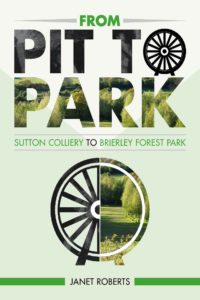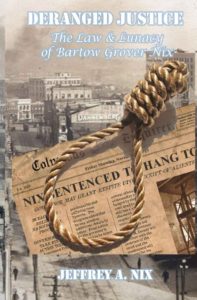 Title: From Pit to Park
Title: From Pit to Park
Author: Janet Roberts
Designer: Ebook Design
Genre: History
Graphics: This is an account of how an abandoned English pit mine was turned into a park. The designer wanted to show the “before” and “after” and chose to do so partly by using a free-standing image and partly by making the text itself into images.
The free-standing image is in two parts. The left side is half of an illustration of a spoked wheel, the whole illustration being used as the letter O in the title.
What does this wheel represent, other than the pit mine in general? Was it part of a pulley system by which ore was hauled to the surface? Was it something else? There’s no indication.
The wheel isn’t solid black. It actually uses a black-and-white photo for its fill. The photo seems to be an old one of a mine worker. The same man appears more clearly in the second T of the title. You have to look close to see him there and closer still to see him in the wheel. At thumbnail size you can’t see him at all.
The right side of the free-standing image is a circle, with lines mimicking the left side, but this circle isn’t a spoked wheel. It’s a recent photo of the park that has replaced the mine. It’s the only part of the graphics that doesn’t require the viewer to pause to figure out what he’s seeing.
Typography: The title comes in three segments. The initial word, “From,” is easily overlooked since it is so much smaller than the other words. It would be better to make all four words the same size and to put them in two lines: “From Pit/ to Park”. That would require a more condensed font, but it would prevent readers from seeing the title as having only three words.
It would have another advantage. It would remove the preposition “to” from the end of a line. Prepositions should be kept, whenever possible, with the remainder of their phrases.
The biggest problem with the title is the transformation of the letters into images. It doesn’t work well. When the cover is seen at thumbnail size, the words “Pit to” seem to be mottled gray, and “Park” seems to be green and dark green. It’s only when the cover is seen at a larger size that one perceives that the upper line has that black-and-white photo as its fill while the lower line uses the same recent photo as is used in the free-standing image.
Since the spoked wheel is used below, as part of the free-standing image, there is no good reason to shoehorn it into the title as the letter O. It confuses the reader, who will be confused enough trying to read text that really consists of photos.
The subtitle doesn’t stand out well because it is dark green letters against a light green background. It would have been better to make the subtitle black. If it were to remain green, the lone word now in black, “to,” also should be green. It presently draws too much attention to itself.
The best text is the author name, but it ought to be at least twice as large. At least it’s legible, even at a small size.
Overall: This seems to be a case of the designer trying too hard, adding symbolism in too many places. If the type were kept to straight type, with the proposed modifications, and if the free-standing image were the only image in sight, this cover would be far better.

 Title: Deranged Justice
Title: Deranged Justice